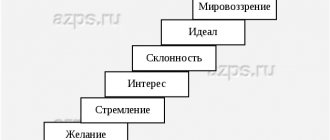Classification
Firstly, the motive gives a real impetus to activity, that is, it sets it in motion, turns it on, and supplies it with energy. But “motivate” does not necessarily mean “cause”, or actually lead to the presence of activity. A person has more motives and aspirations than expressed implementations of activity, so it is useful to separate two levels of the general function of motivation:
- The presence of a potential selective drive that does not necessarily lead to formalized activity, but has psychological expression;
- implemented stimulation, which is usually the name of the specific activity selected and initiated.
The second function of a motive is to give direction to the activity generated. It is not enough to start an activity and constantly “feed” it. It is necessary to lead it and implement it. This is a function of managing active processes to bring them to the planned result. The activity is aimed at its object, which, according to A.N. Leontyev, is the motive.
The third function of the motive is resin formation, thanks to which the concept of motive reaches the subjective, personal level. Subjective meaning arises in activity, in the relationship between motive and goal. Meaning is the answer to the question: why, why does a person need an object of his needs and activities? In a developed personality this question can be decisive.
Thus, the meaning-forming function of the motive becomes psychologically central. They say that man is a meaning-oriented creature. If there is no compelling personal meaning, the motive simply will not work as a motivator. There will be no activity as such, although the unrealized motive will remain.
In modern psychology there is no exhaustive and generally accepted classification of needs and motives.
- motives are distinguished depending on the nature of the needs to which they correspond, for example, there are higher and lower motives, material and spiritual. The above gradations are quite arbitrary. For example, clothing as a motif is equally associated with the material and the spiritual. There is a special class of functional needs and motives. Their essence lies in the fact that the source of activity is a person’s need to function. Motives can be divided into types in accordance with one of the existing classifications of needs, in particular, in accordance with A. Maslow’s “pyramid”. The variety of such schemes seems inexhaustible.
- Motives are distinguished by the form of reflection of the object of need; a motive can be, for example, a direct sensory image, an image of memory, or imagination. Various psychological formations act as motives: a moral concept or idea, an ideal, a value orientation. This allows motivational psychology to explore the complex realities of human existence itself without, for example, simplifying it into purely material stimulus-response constructs.
- Every real human activity is multi-motivated, i.e. is subordinated not to one, but to several motives, their entire hierarchical system. This leads to a kind of splitting, a division of functions between several motives. For example, broad motives perform a meaning-forming function, and narrow motives are the motives themselves. For example, a person spends a long time performing a subjectively unnecessary and uninteresting task. Then prosaic motives appear as narrow and short-term incentives: the threat of punishment, the opportunity for reward, or the simple need to act.
- And lastly, motives are divided depending on the degree of involvement in their consciousness. Therefore, motives can be conscious and unconscious, “understandable” and really effective. Suppose a high school student knows that he needs to study for the future, for deeper knowledge. But it is unlikely that such a motive is actually active for him.
True motivation to learn comes from duty, imitation of peers or parents. But for a school graduate who previously only understood, the motive can be transformed into a motive to actually act. This changes both educational activity, and the subjective attitude towards it, and the motivational state of a person. A similar redistribution of functions can occur between conscious and unconscious motives.
Types of motives
Motives are usually divided into drives and drives. Drives are primarily biological, such as thirst, hunger, sleep and the need to reproduce - all of which motivate us to seek out and engage in certain activities. Drives are thought to originate within the individual and may not require external stimuli to encourage behavior. On the other hand, motives are mainly determined by social and psychological mechanisms such as work, family and relationships. These include factors such as praise, approval, etc.
Basic criteria for the concept of motive in human activity
1 Motives are formed in the process of individual development as relatively stable evaluative dispositions.
2 People differ in the individual expression (character and strength) of certain motives. Different people may have different hierarchy of motives.
3 A person’s behavior at a given moment in time is motivated not by any or all of his motives, but by the highest (i.e., strongest) motive in the hierarchy, the one that comes closest to the prospect of achieving the corresponding goal state in given conditions or the achievement of which is under question. This motive is activated and becomes effective. (Other motives, subordinate to it or in conflict with it, can be activated simultaneously).
4 The motive remains active, i.e. participates in the motivation of behavior until either the target state of the corresponding “individual-environment” relationship is achieved, or the individual approaches it as much as the conditions of the situation allow, or the target state ceases to move dangerously away, or the changed conditions of the situation make another motive more relevant, as a result of which the latter is activated and becomes dominant. The action, like the motive, is often interrupted before the desired state is achieved or breaks up into parts scattered over time; in the latter case it usually resumes after some time.
5 Motivation explains the direction of action to achieve a goal.
6 Motivation, of course, is not a single process that uniformly permeates behavioral actions from beginning to end. Rather, it consists of heterogeneous processes that perform a self-regulatory function at various stages of behavioral action, especially before and after its execution. activity is motivated, that is, aimed at achieving the goal of the motive, but it should not be confused with motivation.
Activity consists of individual functional components of perception, thinking, learning, knowledge reproduction, speech or motor skills, and they have their own reserve of capabilities (abilities, skills, knowledge) accumulated over a lifetime, which the psychology of motivation cannot cope with, taking them for granted.
Motivation determines how and in what direction various functional abilities are used. Motivation also explains the choice between different possible actions, between different perceptions and possible thought contents; moreover, it explains the intensity and persistence in carrying out the chosen action and achieving its results.
The motive of human activity is, of course, connected with purpose. But the motive can be separated from the goal and will move:
1) by the activity itself, for example, a person does something out of love for art.
2) to one of the results of the activity, i.e. the by-product becomes the goal of the activity.
Types of motives in psychology
Psychologists identify a large number of types of motives, dividing them into several categories. It is not easy to create such a classification, since there are a lot of circumstances that guide a person; Each direction of psychology and each school has its own system. However, the most widespread division of motives into four groups.
Internal and external motives
These types are important not only in terms of the choice of means and ways to achieve the goal, but also for the self-realization of human individuality. Internal motives are such as interests, hobbies, the need for positive emotions and avoidance of negative ones, the desire to increase self-esteem, etc. These circumstances are related to the person himself and his attitude to his activities.
External motivation is circumstances that do not depend on a person and his desires and lie outside his personal sphere. These may be motives such as public opinion, a change in weather, the desire to get a higher grade or avoid punishment, etc.
External and internal motivations can work simultaneously, or they can act separately. For example, a student diligently does his homework. He can do this both because he is interested in the topic, and in order to get a good grade, please his parents, brag to his friends, etc.
External motivation plays a fairly large role in human life, since most people need a certain socialization. Such motives are often more effective than internal ones; this is the same “kick in the ass” without which some people will not do anything at all. However, for personal development, internal motives are still the most preferable. Only with their help can you do your work truly productively. All creative activity is based primarily on internal motivation.
Motive and motivation
Motive
A driving and directing force that arises on the basis of needs, forcing a person to take certain actions that contribute to the achievement of a goal, that is, the satisfaction of a need.
Based on motive, a broader concept arises - motivation.
Motivation
A holistic system, a set of psychological factors that determine and explain a particular human behavior.
Motivation is characteristic not only of humans, but also of animals. The distinctive feature of one system from another is the motive. Modern man is driven by needs, often artificially created by himself or other people, while animals are driven by natural instinct. In addition, human motivation has a clear hierarchy, which animals do not have.
Basic human motives
If we consider the main motives of a person as an individual and a species as a whole, then the main (primary) motives will be those related to existence, i.e. biological (physiological), innate: hunger, thirst, sleep and sex . They cannot be changed by willpower. Some of them are cyclical - food, sleep.
Many of the basic motives are ignored due to everyday life, but they are the basis of many economic activities and if they cannot be satisfied, they endanger life expectancy: movement, clean air, adequate ambient temperature, etc.
Therefore, they are important and necessary processes to ensure the survival of humans and the species. Other primary motives are escaping danger or seeking shelter to protect oneself.
Types (forms) of activity
Within the framework of a social studies course, there are usually four main forms of activity - play, learning, work and communication.
- A game is a free developmental activity that a subject performs at will and for the pleasure of the process. The game usually has a clear set of rules. During play, children often prepare for adult activities - study, work, family relationships.
- Learning (cognition) is a conscious and purposeful process of acquiring new knowledge and skills.
- Labor is the process of interaction between a subject and the outside world, during which the former creates products necessary to satisfy individual and social needs.
- Communication is the process of establishing and developing contacts between people, which includes the exchange of information, experiences, and emotions.
Game as a special type of activity
The purpose of the game is not the production of a material product, but the process itself, during which the child relaxes and has fun. This makes play different from other activities that have a clear goal.








